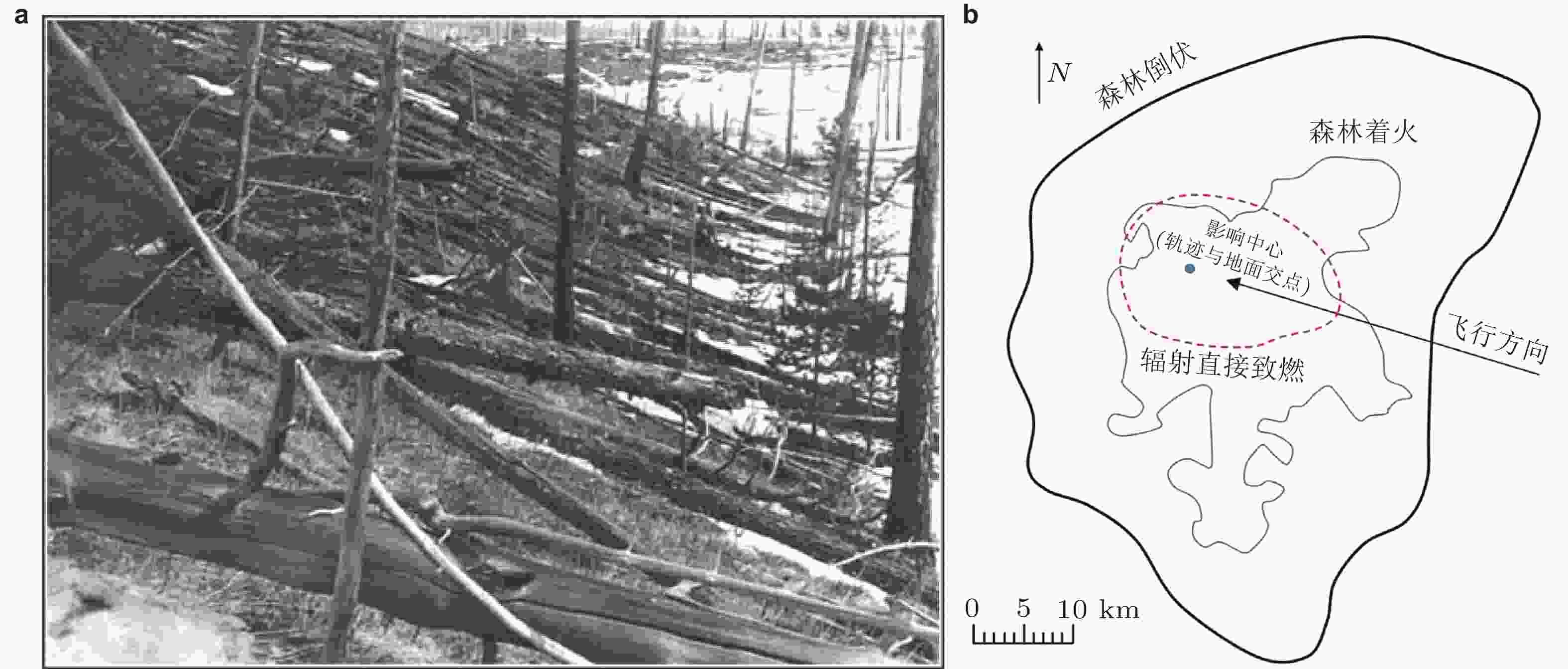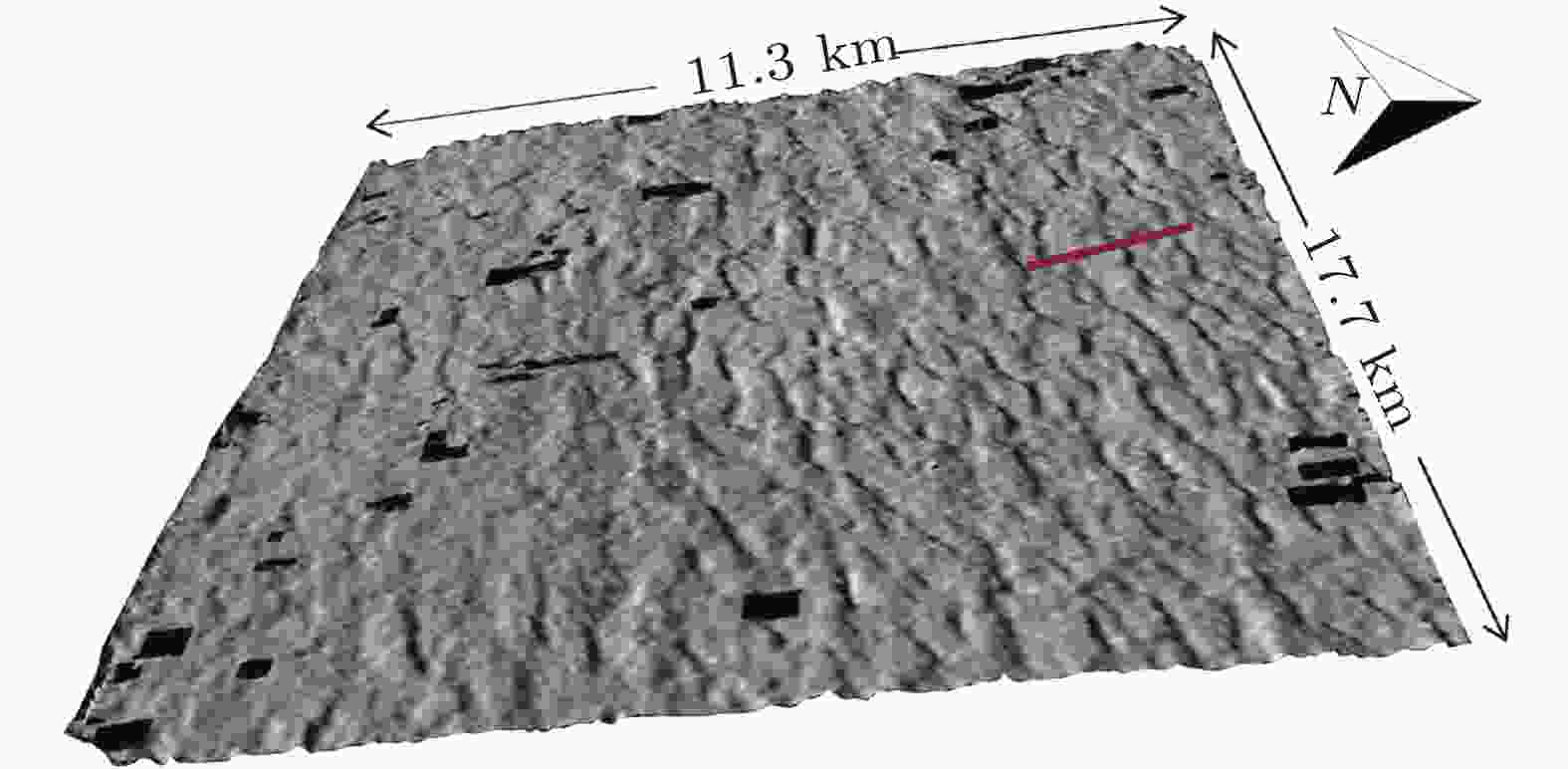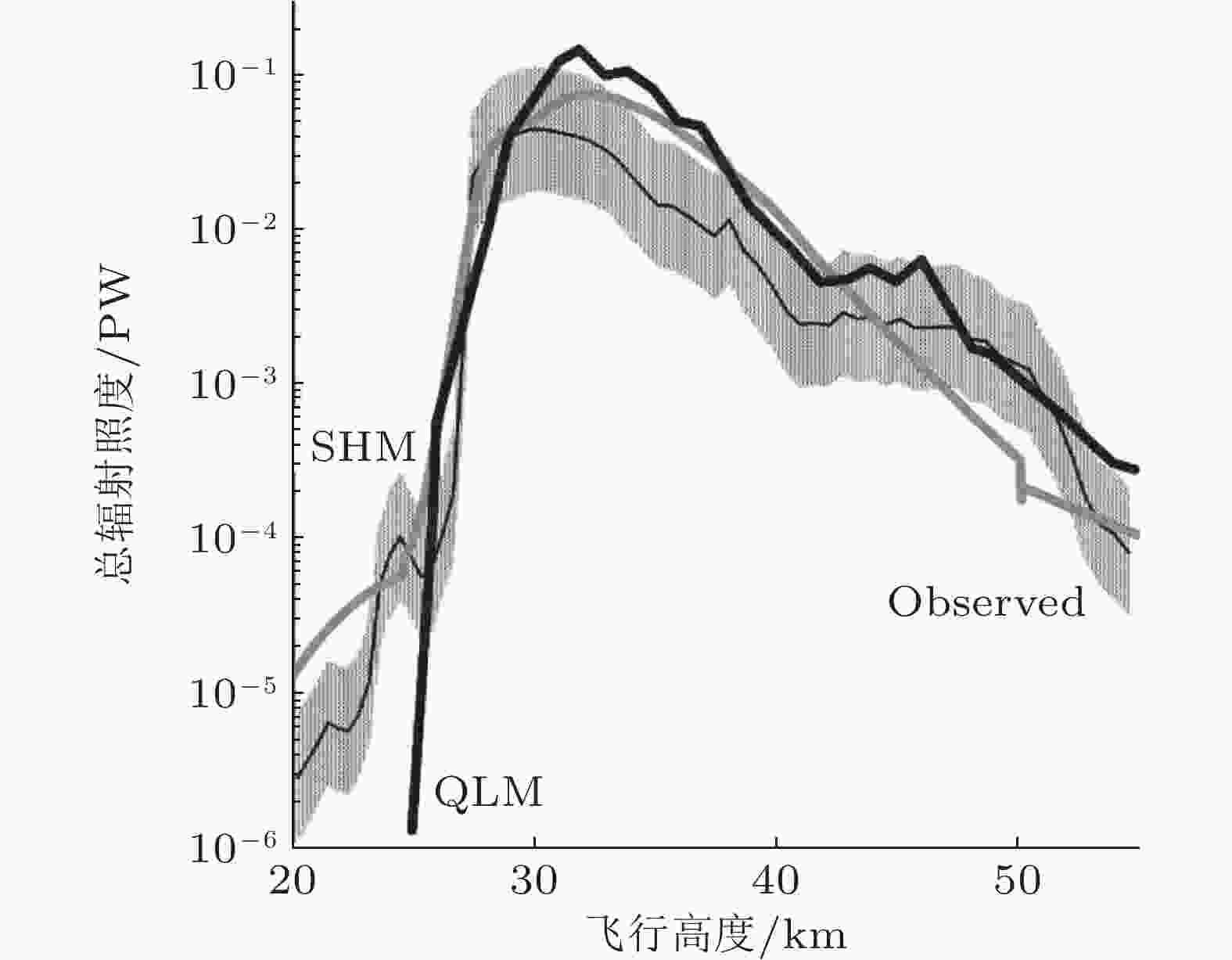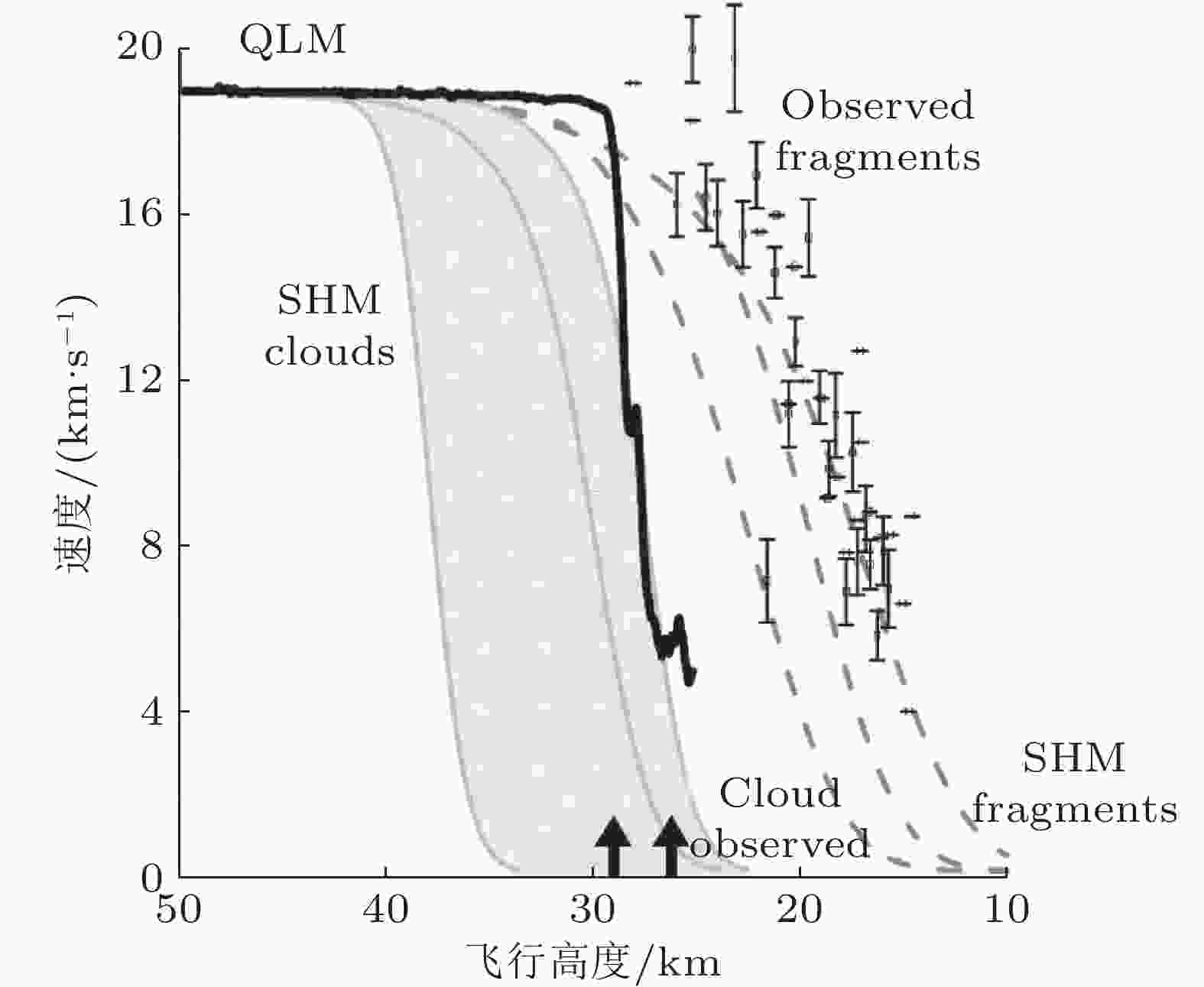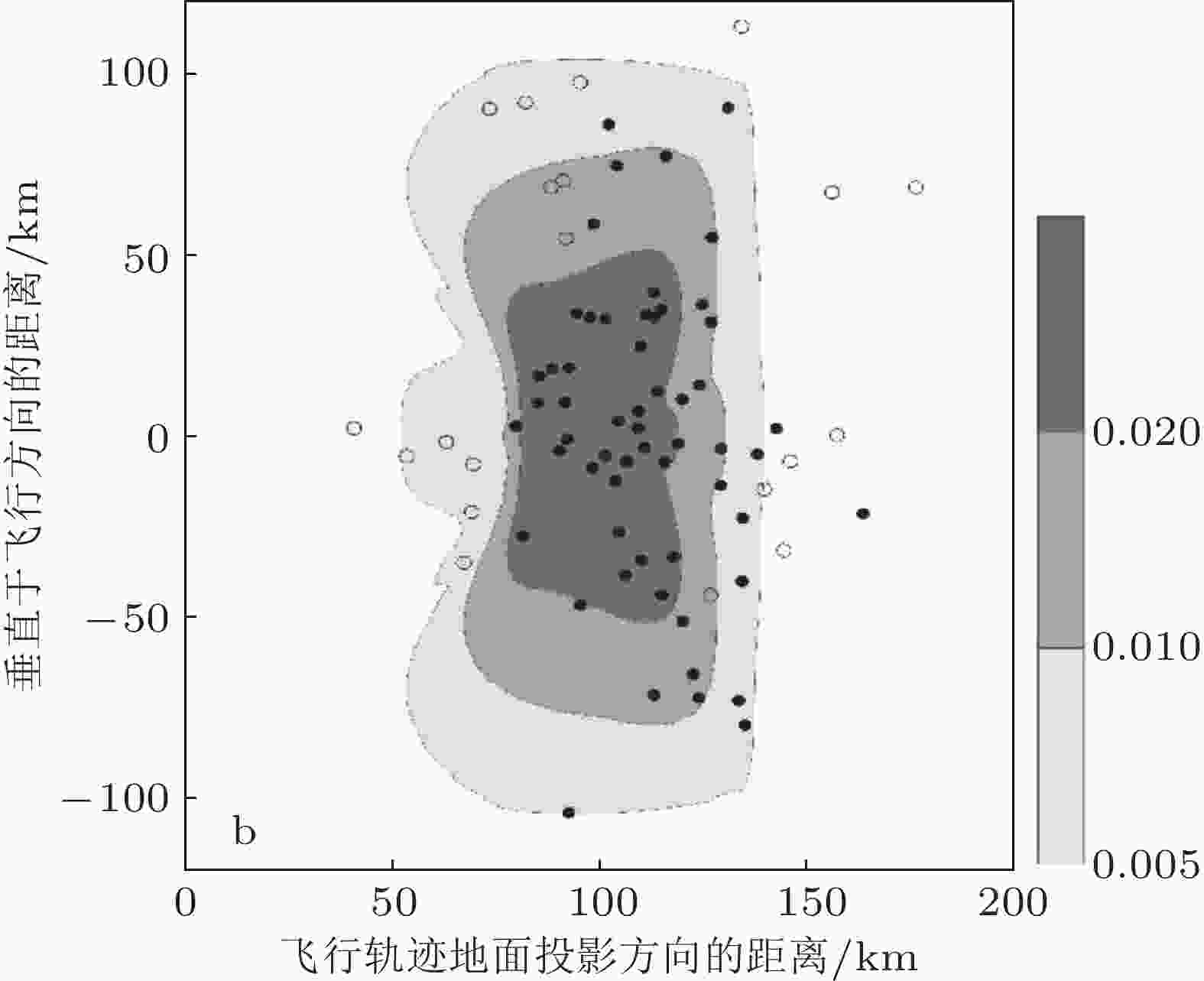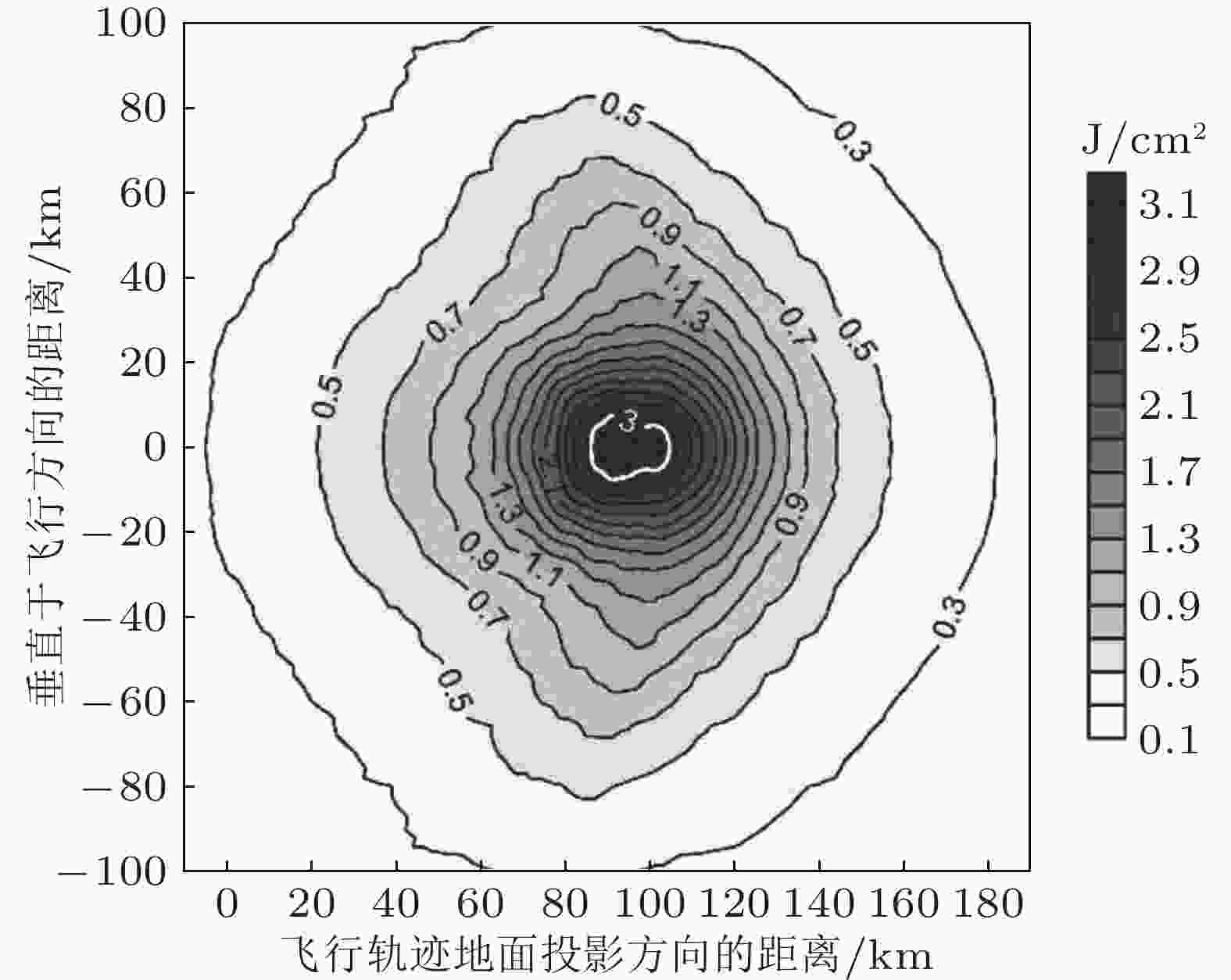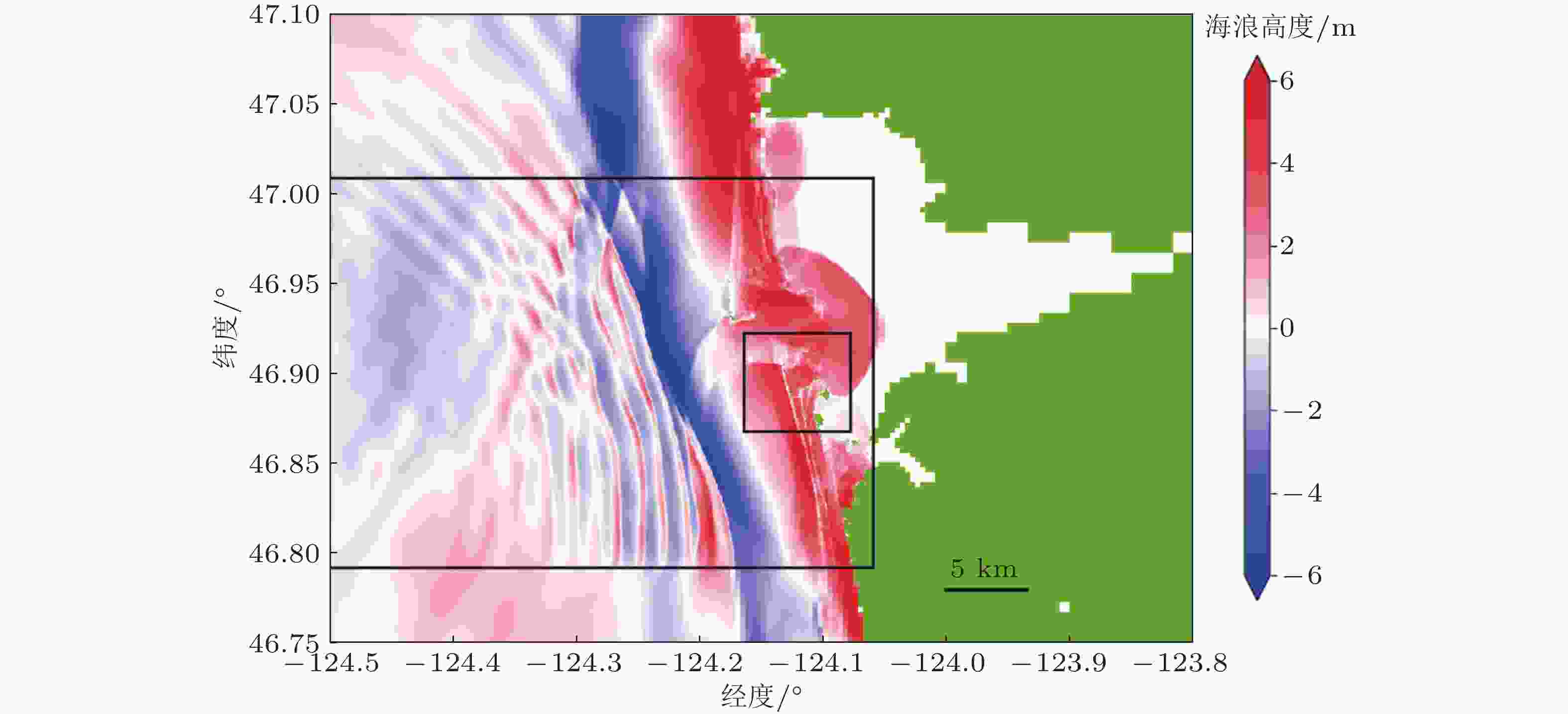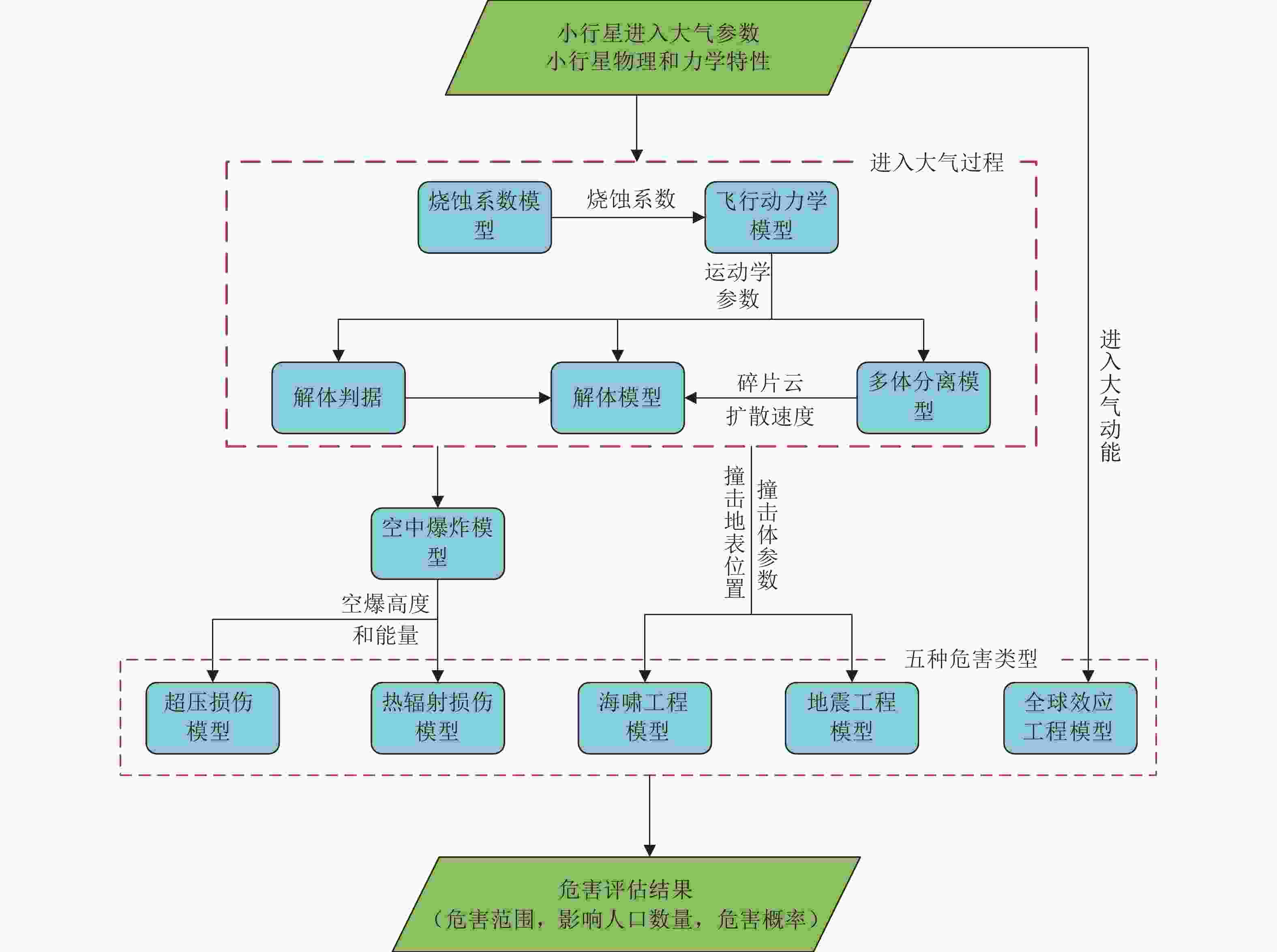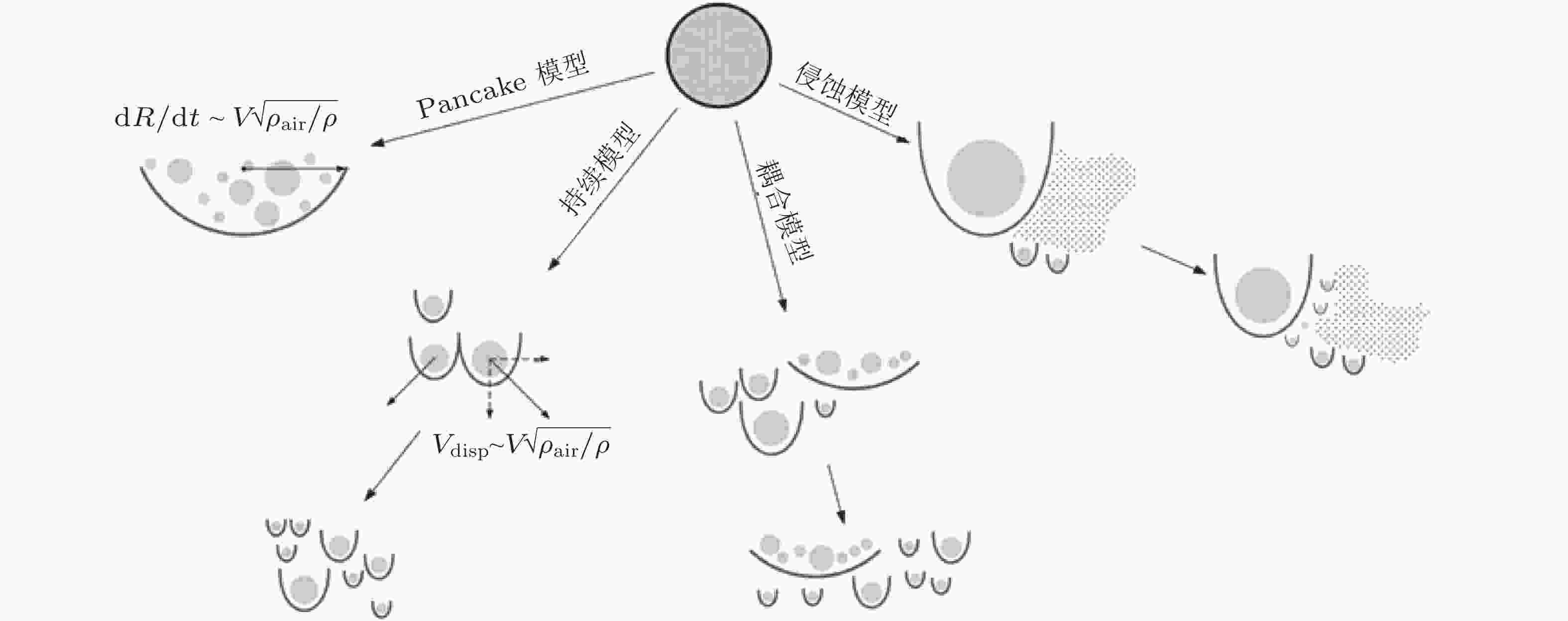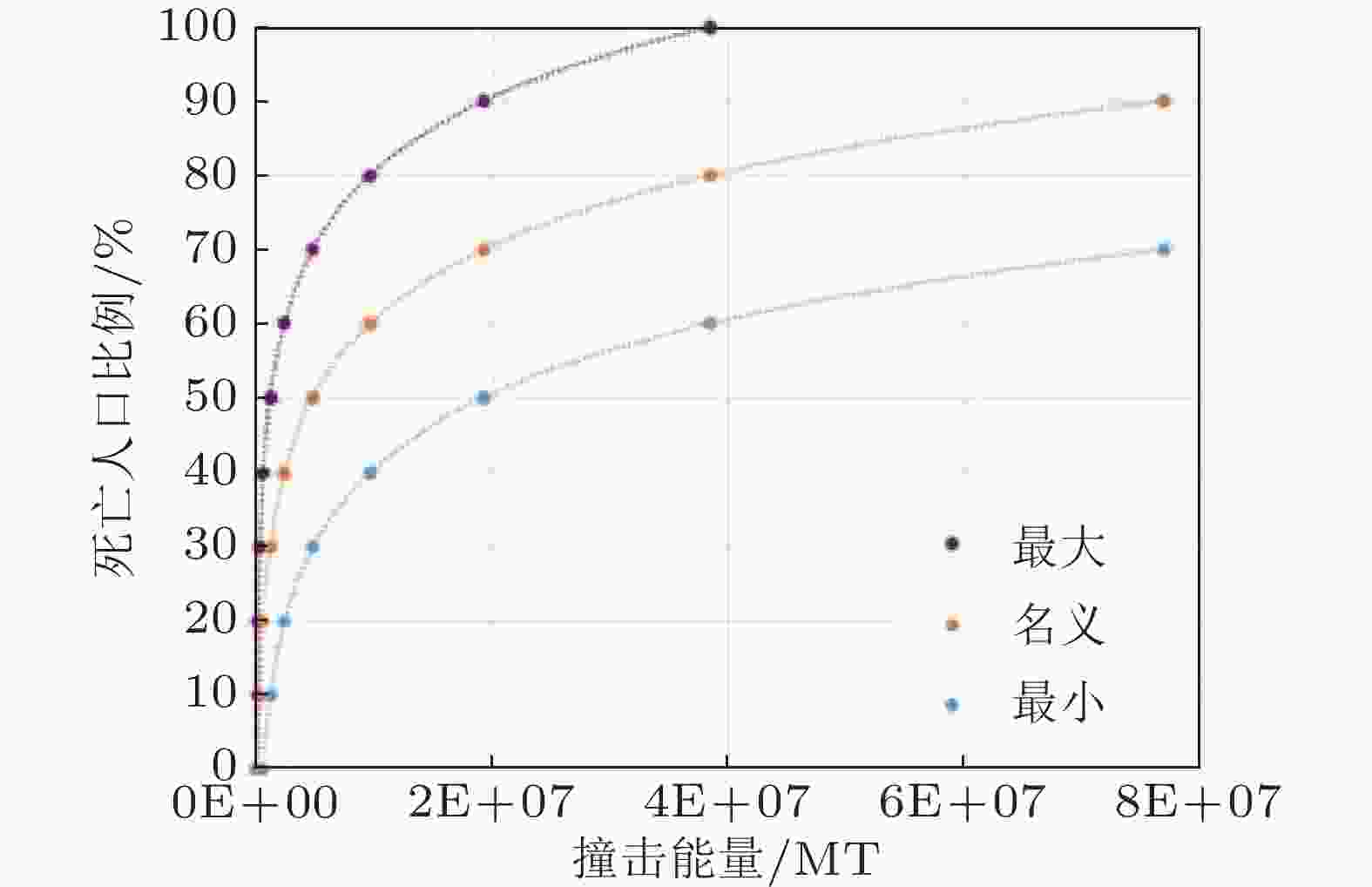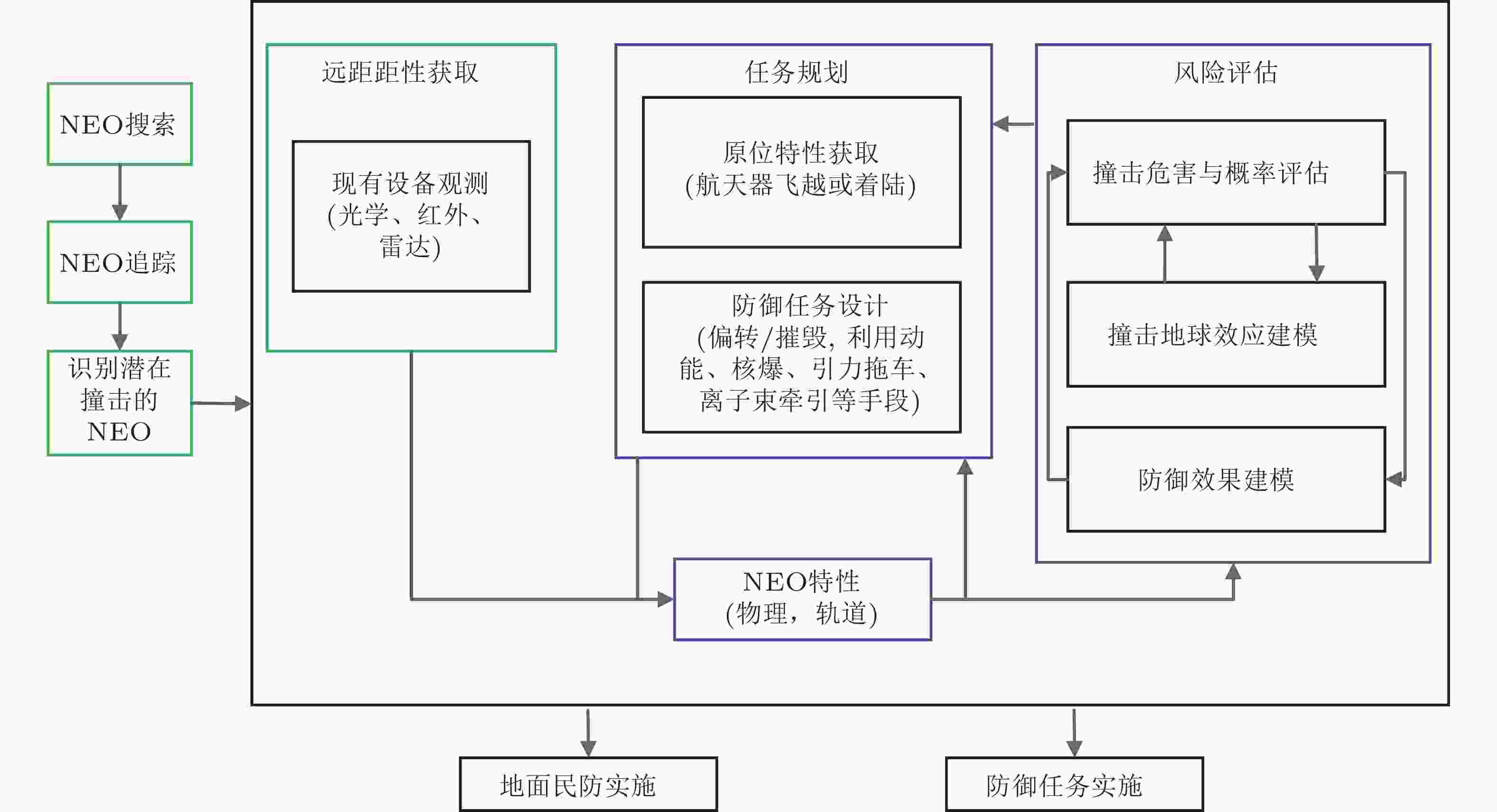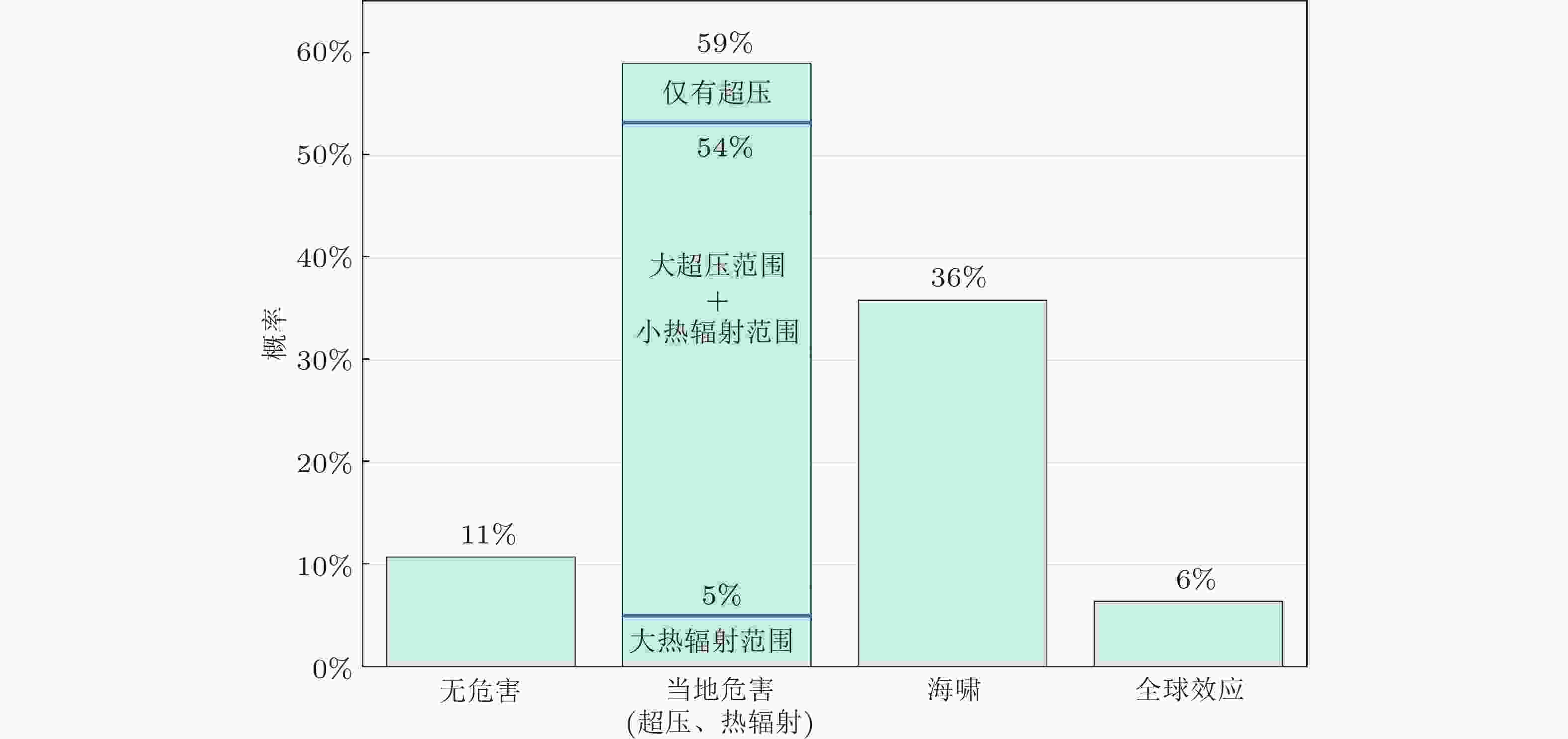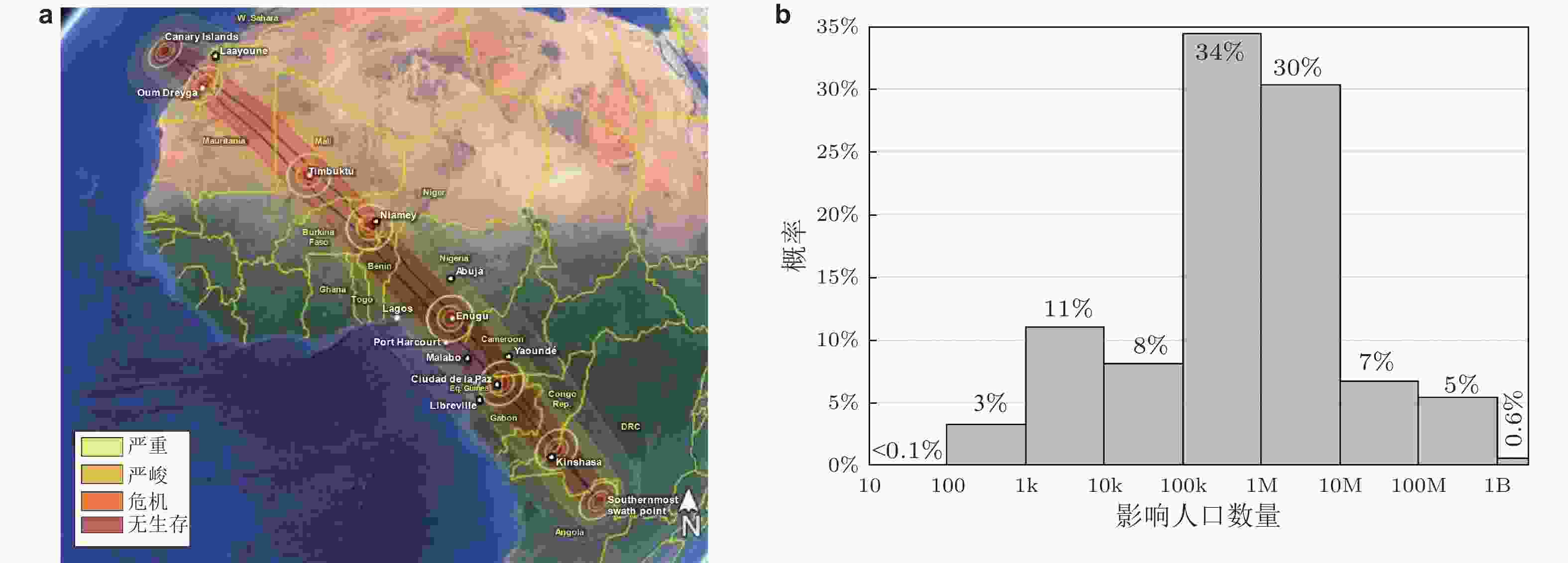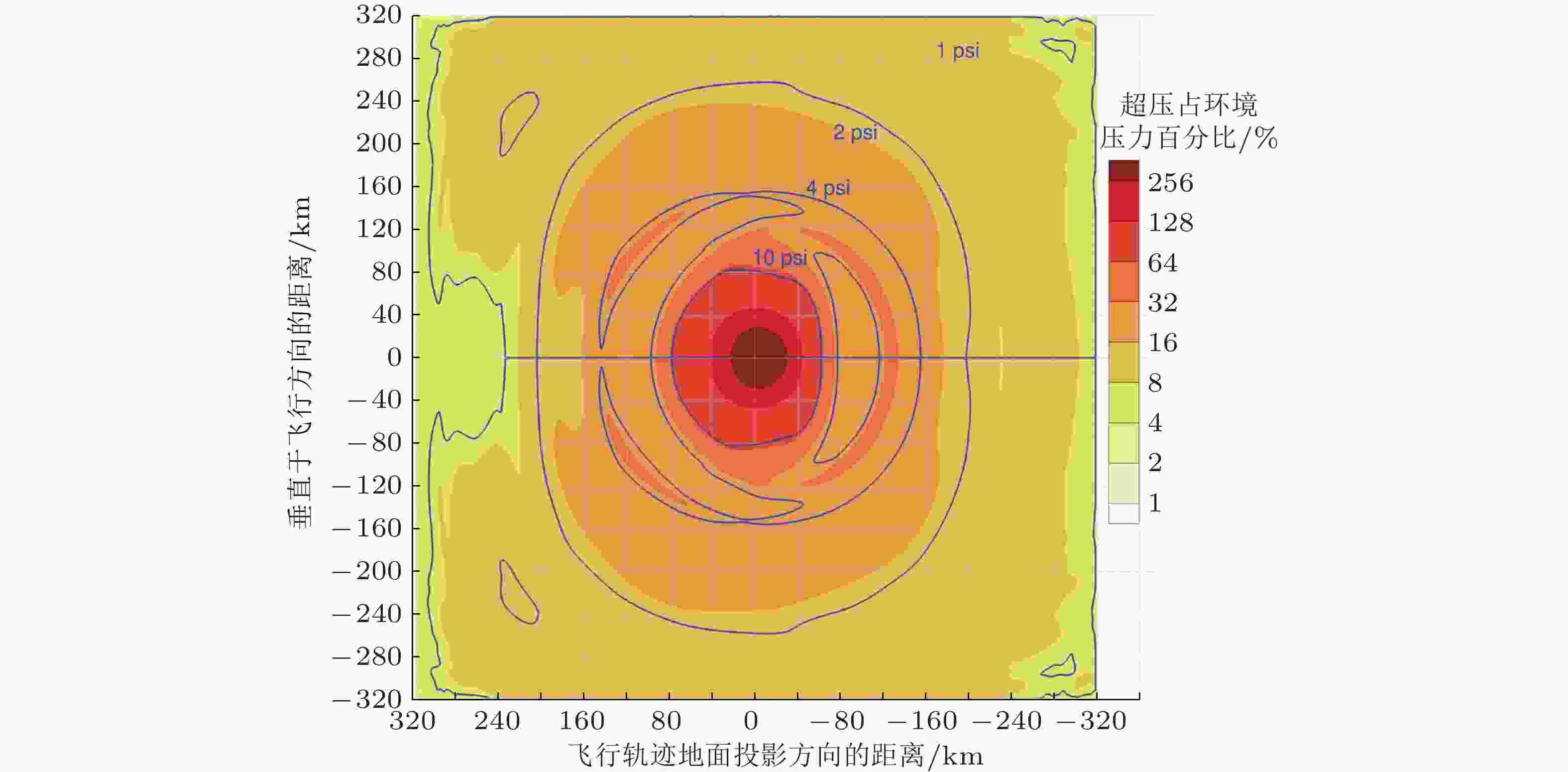-
摘要: 小行星撞击地球是人类生存和发展的潜在威胁之一. 行星防御是国际上近20年来兴起的热点研究领域, 也是我国重大安全需求. 小行星撞击地球危害评估是行星防御重要研究内容. 本文认为, 小行星撞击地球危害具有概率低、危害大、随机性的特点, 存在超压、热辐射、地震、海啸、全球效应五种危害类型, 危害评估有防御决策阶段、防御实施阶段、地面民防阶段三个应用场景. 本文总结了五种危害类型的研究现状, 从模型、方法与软件三个方面重点阐述了数值仿真与工程计算这两种危害评估手段的研究进展, 介绍了危害评估的输入输出与典型案例, 简要阐述了小行星撞击地球力学问题研究进展, 指出当前研究存在的不足, 并对未来工作进行展望.Abstract: Asteroid impact on earth poses a potential threat to humanity. Over the past 20 years, planetary defense has become a hot research area internationally, and it is also a crucial security requirement for our country. Assessing the hazards of asteroid impact on earth is a significant research topic within planetary defense. It is noted that asteroid impacts on earth exhibit characteristics of low probability, high hazard and randomness. These hazards include overpressure, thermal radiation, earthquake, tsunami, and global effects. Hazard assessment is applied in three scenarios: defense decision-making, defense implementation, and ground civil defense. The input and output of hazard assessment, the progress of numerical simulation and engineering computation in hazard assessment in terms of model, method and software, as well as the research status of the five types of hazards, are summarized. Furthermore the advancement of hypervelocity issues of earth impact by asteroid is presented. Finally, the current research limitations are identified, and prospects for future work are provided.
-
Key words:
- asteroid /
- impact on earth /
- hazard assessment /
- model and method
-
图 1 近地天体直径、绝对星等、撞击能量与数量和撞击地球频率关系 (Stokes et al. 2017)
图 2 Tunguska小行星撞击后当地森林破坏情况. (a) 勘察照片 (Vasilyev 1998), (b) 当地森林倒伏、辐射直接致燃与着火范围 (Johnston & Stern 2018)
图 3 Chicxulub小行星撞击海啸产生的海底波纹 (Kinsland et al. 2021)
图 4 SOVA软件对Chelyabinsk小行星进入大气能量沉积的模拟结果 (Shuvalov et al. 2017). 图中纵轴单位1 PW = 1015 W; QLM (粗黑色实线) 表示QL模型计算结果; SHM (粗灰色实线) 是SH解体模型计算结果; Observed (细黑色实线) 是基于视频的观测结果, 周围灰色区域表示观测结果的不确定度
图 5 SOVA软件对Chelyabinsk小行星进入大气飞行轨迹的模拟结果 (Shuvalov et al. 2017).图中QLM (粗黑色实线) 表示QL模型计算结果; SHM (粗灰色实线、粗灰色虚线) 是SH解体模型计算结果; 横轴上的箭头Cloud observed表示观测得到的尾迹云飞行高度; Observed fragments表示碎片飞行轨迹的观测结果
图 6 SOVA软件对Chelyabinsk小行星进入大气地面超压的模拟结果 (Shuvalov et al. 2017).图中实心点表示当地建筑物玻璃损坏位置, 空心点表示无损坏. 各级等值线表示不同超压量值, 由外至内依次为500、1000、2000 Pa, 右侧的等值线图例为超压与环境压力的比值. 根据Popova等 (2013) 的研究, 500 Pa使玻璃损坏, 1000 Pa使玻璃严重损坏
图 7 SOVA软件对Chelyabinsk小行星进入大气地面辐射照度的模拟结果 (Shuvalov et al. 2017).图中等值线表示辐射照度
图 8 GeoClaw软件对假想撞击海啸的模拟结果 (Berger & LeVeque 2021). 云图表示撞击后50 min的海浪高度, 模拟位置为太平洋西海岸美国华盛顿州格雷斯港, 撞击位于格雷斯港以西150 km, 海底深度4 km, 模拟初始条件为直径3 km、宽度1 km的瞬时撞击坑, 采用ALE3D软件模拟该瞬时撞击坑的演化并将251 s的模拟结果作为初值用于GeoClaw软件对水波传播的模拟
图 10 解体模型分类 (Galina et al. 2019)
图 11 基于美国核试验数据对Tunguska小行星进入大气地面超压损伤范围的计算结果 (党雷宁和柳森 等 2021)
图 12 小行星撞击地球全球效应死亡人口比例与撞击能量的关系 (Stokes et al. 2017)
图 13 NASA的小行星进入与撞击地面风险分析评估系统PAIR (Wheeler et al. 2023a)
图 14 第7届IAA行星防御会议桌面演习流程 (Barbee et al. 2021)
图 15 第8届IAA行星防御会议桌面演习风险走廊 (Chodas 2023)
图 16 第8届IAA行星防御会议桌面演习历元1的危害评估工程计算结果 (Wheeler et al. 2023b). (a) 沿风险走廊北美区域当地危害范围, 黑色实线表示撞击走廊边界 (损伤中心) 位置, 不同色彩覆盖区域表示“严重” 、“严峻” 、“危急” 、“无生存”的当地危害等级范围, 环形覆盖区域为局部取样位置的当地危害等级范围. (b) 危害概率随影响人口数量区间变化的直方图, 确定撞击下的结果用白色直方图表示, 考虑撞击概率的结果用灰色直方图表示
图 17 第8届IAA行星防御桌面演习历元1各危害类型发生概率 (Wheeler et al. 2023b)
图 18 第8届IAA行星防御会议桌面演习历元2的危害评估工程计算结果 (Wheeler et al. 2023c). (a) 沿风险走廊当地危害范围, 黑色实线表示撞击走廊边界的损伤中心位置, 不同色彩覆盖区域表示“严重” 、“严峻” 、“危急” 、“无生存”的当地危害等级范围, 环形覆盖区域为局部取样位置的当地危害等级范围. (b) 危害概率随影响人口数量区间变化的直方图
图 19 第8届IAA行星防御会议桌面演习历元2的地面超压数值仿真结果 (Aftosmis et al. 2023). 模拟条件: 小行星直径800 m、进入角54°. 模拟所需的能量沉积来自PAIR软件计算结果. 图中坐标原点为空爆点的星下点
表 1 小行星直径与危害程度关系 (Barbee et al. 2021)
小行星直径/m 事件类型 撞击能量/MT 平均撞击频率/years 5 火流星 0.01 1 10 超级火流星 0.1 10 25 空爆 1 100 50 当地尺度危害 10 1000 140 区域尺度危害 300 20,000 300 大陆尺度危害 2,000 70,000 600 全球尺度危害下限 20,000 200,000 1000 全球尺度危害 100,000 700,000 5000 全球尺度危害上限 10,000,000 30,000,000 10000 物种灭绝 100,000,000 100,000,000 注: 当地尺度: 大城市; 区域尺度: 省或小国家. 表 2 NASA Ames研究中心的当地危害等级 (Wheeler et al.2023a)
危害等级 影响人口比例/% 冲击波 热辐射 超压量值/
psi效应 1 MT进入动能下点燃材料的
辐射照度/MJ/m2效应 严重 10 1 窗户玻璃摇晃、个别建筑物受损 0.25 二级烧伤 严峻 30 2 大量建筑受损 0.42 三级烧伤 危急 60 4 大多数建筑物倒塌 1.0 衣物燃烧 无生存 100 10 建筑物完全毁坏 — 建筑物燃烧 注: 1 psi = 6895 Pa. 表 3 小行星撞击地球危害评估数值仿真软件对比
软件 超压 热辐射 地震 海啸 全球效应 主要模型与方法 是否参加行星
防御演习备注 SOVA √ √ × × × 准液体模型, 欧拉方法 × 冲击动力学软件 CTH √ × × √ × 准液体模型, 欧拉方法 √ 冲击动力学软件 ALE3D √ × × √ √ 强度模型, 欧拉方法 × 冲击动力学软件 iSALE √ × × × × 准液体模型, 欧拉方法 × 冲击动力学软件 NTS √ × × × × 强度模型, 欧拉方法 × 冲击动力学软件 Cart3D √ × × × × 能量沉积源项, 无黏高
超声速流动模拟方法√ 空气动力学软件 Laura +
MODTRAN× √ × × × 能量沉积源项, 热化学非
平衡流动模拟方法, 大气
传输模拟方法× 空气动力学软件 SAGE √ × × √ × 欧拉方法 × 冲击动力学软件 GEODYN +
WWP√ × × √ × 欧拉方法, 浅水波方程 √ 冲击动力学软件 +
水波动力学软件ALE3D +
GeoClaw√ × × √ × 欧拉方法, Boussinesq方程 √ 冲击动力学软件 +
水波动力学软件CESM × × × × √ 气候模拟方法 × 古气候模拟软件 注: “√”:表示具备该功能; “×”表示不具备该功能. 表 4 国内外小行星撞击地球危害评估软件功能对比
弹道 烧蚀 解体及空
中爆炸陨石质量、
落区超压 热辐射 海啸 地震 全球效应 伤亡人口 概率评估 美国NASA的PAIR软件 √ √ √ √ √ √ √ × √ √ √ 伦敦帝国理工大学的
网页版软件√ √ √ × √ √ √ √ √ × × 俄罗斯科学院的
网页版软件× × √ × √ √ × √ × × × CARDC的
AICA软件√ √ √ √ √ √ × √ √ × × 注: “√”:表示具备该功能; “ × ”表示不具备该功能. -
[1] 党雷宁, 柳森, 白智勇, 等. 2021. 小行星进入与撞击效应评估模型敏感性研究. 力学学报, 531: 278-292 (Dang L N, Liu S, Bai Z Y, et al. 2021. Sensitivity research on models of earth entry and impact effects by asteroids. Chinese Journal of Theoretical and Applied Mechanics, 531: 278-292).Dang L N, Liu S, Bai Z Y, et al. 2021. Sensitivity research on models of earth entry and impact effects by asteroids. Chinese Journal of Theoretical and Applied Mechanics, 531: 278-292 [2] 党雷宁, 梁世昌, 黄洁, 等. 2021. 吉林松原流星进入大气层过程及对地面的影响分析. 空间碎片研究, 21(4): 62 : 71 (Dang L N, Liang S C, Huang J, et al. 2021. Analysis on earth entry process and influence on ground of Songyuan Meteor. Space Debris Research, 21 (4): 62: 71).Dang L N, Liang S C, Huang J, et al. 2021. Analysis on earth entry process and influence on ground of Songyuan Meteor. Space Debris Research, 21(4): 62: 71 [3] 陈鸿, 赵君尧, 周浩, 等. 2021. 小行星撞击成坑及反溅碎片云影响因素研究. //第三届全国行星防御研讨会. 8 .21-23, 2020, 南京, 中国 (Chen H, Zhao J Y, Zhou H, et al. 2021. Influence factor of crater and ejector of asteroid impact earth’s surface//The 3rd Planetary Defense Symposium, 21-23, August, 2020, Nanjing, China).Chen H, Zhao J Y, Zhou H, et al. 2021. Influence factor of crater and ejector of asteroid impact earth’s surface//The 3rd Planetary Defense Symposium, 21-23, August, 2020, Nanjing, China [4] 陈坚强, 涂国华, 张毅锋, 等. 2017. 高超声速边界层转捩研究现状与发展趋势. 空气动力学学报, 35 (3): 311-337 (Chen J Q, Tu G H, Zhang Y F, et al. 2017. Hypersonic boundary layer transition: what we know, where shall we go. Acta Aerodynamics Sinica, 35 (3): 311-337).Chen J Q, Tu G H, Zhang Y F, et al. 2017. Hypersonic boundary layer transition: what we know, where shall we go. Acta Aerodynamics Sinica, 35(3): 311-337 [5] 刘丹. 2023. 空间超远程雷达探测与基于模型的信息理解. //第二届全国行星防御大会, 7.16-20, 2023, 伊宁, 中国 (Liu D. Space-based long-range radar detection and model-based information understanding. // The 2nd China National Planetary Defense Conference, 16-20, July, 2023, Yining, China).Liu D. Space-based long-range radar detection and model-based information understanding. // The 2nd China National Planetary Defense Conference, 16-20, July, 2023, Yining, China [6] 刘芹芹, 申旭辉, 周炳红, 等. 2022. 近地小行星撞遇地球灾害链效应. 空间碎片研究, 22(1): 1-17 (Liu Q Q, Shen X H, Zhou B H, et al. 2022. Disaster chain effects from near-earth asteroids collision with earth surface. Space Debris Research, 22(1): 1-17).Liu Q Q, Shen X H, Zhou B H, et al. 2022. Disaster chain effects from near-earth asteroids collision with earth surface. Space Debris Research, 22(1): 1-17 [7] 柳森, 党雷宁, 赵君尧, 等. 2018. 小行星撞击地球的超高速问题. 力学学报, 50 (6): 1311-1327 (Liu S, Dang L N, Zhao J Y, et al. Hypervelocity issues of earth impact by asteroids. Chinese Journal of Theoretical and Applied Mechanics, 50(6): 1311-1327).Liu S, Dang L N, Zhao J Y, et al. Hypervelocity issues of earth impact by asteroids. Chinese Journal of Theoretical and Applied Mechanics, 50(6): 1311-1327 [8] 刘文近, 张庆明, 马晓荷, 等. 2021. 近地小天体对地撞击成坑模型研究进展. 爆炸与冲击. 41(12): 16 (Liu W J, Zang Q M, Ma X H, et al. 2021. A review of the models of near-earth object impact cratering on earth. Explosion and Shock Waves, 41(12): 16).Liu W J, Zang Q M, Ma X H, et al. 2021. A review of the models of near-earth object impact cratering on earth. Explosion and Shock Waves, 41(12): 16 [9] 李毅, 柳森, 陈鸿, 等. 2018. NTS软件在近地小行星撞击与防御中的应用//全国第一届行星防御研讨会, 1.26-27, 2018, 绵阳, 中国 (Li Y, Liu S, Chen H, et al. 2018. Application of NTS software on planetary defense// The 1st National Conference on Planetary Defense, 26-27, January, 2018, Mianyang, China).Li Y, Liu S, Chen H, et al. 2018. Application of NTS software on planetary defense// The 1st National Conference on Planetary Defense, 26-27, January, 2018, Mianyang, China [10] 罗跃, 王磊, 党雷宁, 等. 2020. 模拟Chelyabinsk小行星进入的烧蚀实验. 力学学报, 52(5): 1362-1370 (Luo Y, Wang L, Dang L N, et al. 2020. Arcjet ablation experiment to simulate the chelyabinsk asteroid entry. Chinese Journal of Theoretical and Applied Mechanics, 52(5): 1362-1370). doi: 10.6052/0459-1879-20-081Luo Y, Wang L, Dang L N, et al. 2020. Arcjet ablation experiment to simulate the chelyabinsk asteroid entry. Chinese Journal of Theoretical and Applied Mechanics, 52(5): 1362-1370 doi: 10.6052/0459-1879-20-081 [11] 欧阳自远, 肇辉. 1986. 吉林陨石研究的十年. 中国科学院院刊, (4)5 (Ouyang Z Y, Zhao H. 1986. 10 years of Jinlin meteorite. Bulletin of Chinese Academy of Sciences, (4)5).Ouyang Z Y, Zhao H. 1986. 10 years of Jinlin meteorite. Bulletin of Chinese Academy of Sciences, (4)5 [12] 秦丽荣. 对“天外来客”吉林陨石保护问题的初步探讨. 2013. 博物馆研究, 4 : 87-91 (Qin L R. 2013. A preliminary study on the protection of Jilin meteorite. Museum Research, 4 : 87-91).Qin L R. 2013. A preliminary study on the protection of Jilin meteorite. Museum Research, 4: 87-91 [13] 石卫波, 党雷宁, 罗跃, 等. 2023. 电弧加热器试验条件下铁质小行星材料烧蚀机理分析. 深空探测学报, 10 (4): 435-441 (Shi W B, Dang L N, Luo Y, et al. 2023. Analysis of ablation mechanism of iron asteroid materials under the condition of arc heater test. Journal of Deep Space Exploration, 10 (4): 435-441).Shi W B, Dang L N, Luo Y, et al. 2023. Analysis of ablation mechanism of iron asteroid materials under the condition of arc heater test. Journal of Deep Space Exploration, 10(4): 435-441 [14] 吴伟仁, 龚自正, 唐玉华, 等. 2022. 近地小行星撞击风险应对战略研究. 中国工程科学, 24 (2): 140-151 (Wu W R, Gong Z Z, Tang Y H, et al. 2022. Response to risk of near-earth asteroid impact. Engineering Sciences in China, 24 (2): 140-151).Wu W R, Gong Z Z, Tang Y H, et al. 2022. Response to risk of near-earth asteroid impact. Engineering Sciences in China, 24(2): 140-151 [15] 杨彦广, 李明, 李中华, 等. 2016. 高超声速飞行器跨流域气动力/热预测技术研究. 空气动力学学报, 34 (1): 5-13 (Yang Y G, Li M, Li Z H, et al. 2016. Aerodynamics force/heating measurement on hypersonic vehicle across different flow regions. Acta Aerodynamica Sinica, 2016, 34 (1): 5-15).Yang Y G, Li M, Li Z H, et al. 2016. Aerodynamics force/heating measurement on hypersonic vehicle across different flow regions. Acta Aerodynamica Sinica, 2016, 34(1): 5-15 [16] 岳宗玉, 史珂, 邸凯昌, 等. 2023. 撞击坑研究进展与展望. 中国科学: 地球科学, 53(11): 2482-2493 (Yue Z Y, Shi K, Di K C, et al. 2023. Progresses and prospects of impact crater studies. Science China Earth Sciences, 66(11): 2441-2451).Yue Z Y, Shi K, Di K C, et al. 2023. Progresses and prospects of impact crater studies. Science China Earth Sciences, 66(11): 2441-2451 [17] 赵坚. 2023. 中国近地小行星监测预警能力体系和国际合作发展展望. //第二届全国行星防御大会, 7.16-20, 2023, 伊宁, 中国 (Zhao J. China’s ability system of monitoring and warning for near-earth asteroids and the prospects for international cooperation in this field. //The 2nd China National Planetary Defense Conference, 16-20, July, 2023, Yining, China).Zhao J. China’s ability system of monitoring and warning for near-earth asteroids and the prospects for international cooperation in this field. //The 2nd China National Planetary Defense Conference, 16-20, July, 2023, Yining, China [18] Agrawal P, Jenniskens P, Stern E C, et al. 2018. Arcjet ablation of stony and iron meteorites. //2018 Aerodynamic Measurement Technology and Ground Testing Conference, 25-29, June, 2018, Georgia, USA. [19] Allen G A, Prabhu D K, Saunders D A. 2015. Trajectory simulation of meteors assuming mass loss and fragmentation //The 1st International Workshop on PHA Characterization, Atmospheric Entry and Risk Assessment, 7-9, July, 2015, NASA Ames Research Center, California, USA. [20] Aftosmis M J, Nemec M, Mathias D L, et al. 2016. Numerical simulation of bolide entry with ground footprint prediction. AIAA 2016-0998. [21] Aftosmis M J, Mathias D L, Tarano A M. 2019a. Simulation-based height of burst map for asteroid airburst damage prediction. Acta Astronautica, 156: 278-283. doi: 10.1016/j.actaastro.2017.12.021 [22] Aftosmis M J, Nemec M, Wheeler L. 2019b. A ground footprint eccentricity model for asteroid airbursts. //The 6th IAA Planetary Defense Conference, 49 April-3 May, Washington DC, USA. [23] Aftosmis M J, Spurlock W, Chiew J, et al. 2023. High-fidelity blast modeling of impact from hypothetical asteroid 2023 PDC. //The 8th IAA Planetary Defense Conference, 3-7, April, 2023, Vienna, Austria. [24] Artemieva N, Shuvalov V V. 2016. From tunguska to chelyabinsk via jupiter. Annual Review of Earth and Planetary Sciences, 44: 37-56. doi: 10.1146/annurev-earth-060115-012218 [25] Artemieva, N, Morgan, J. 2020. Global K–Pg layer deposited from a dust cloud. Geophys. Res. Lett., 47: 1-8. [26] Balakrishnan, A. 1986. Correlations for specific heats of air species to 50, 000 K. AIAA 86-1277. [27] Barbee B, Benson B, Chodas P, et al. 2021. Space mission options for the 2021 PDC hypothetical asteroid impact scenario. //The 7th IAA Planetary Defense Conference, 26-30, April, 2021, Internet. [28] Bath M. 1981. Earthquake magnitude-recent research and current trends. Earth Sci. Rev., 17: 315-398. doi: 10.1016/0012-8252(81)90014-3 [29] Berger M J, LeVeque R J. 2021. Towards adaptive simulations of dispersive tsunami propagation from an asteroid impact. //The 7th IAA Planetary Defense Conference, 26-30, April, 2021, Internet. [30] Bland, P A, Artemieva N A. 2006. The rate of small impacts on earth. Meteoritics & Planetary Science, 41: 607-631. [31] Boslough M, Crawford D A. 1997. Shoemaker-levy 9 and plume-forming collisions on earth. Ann. N. Y. Acad. Sci., 822: 236-82. doi: 10.1111/j.1749-6632.1997.tb48345.x [32] Boslough M, Crawford D A. 2008. Low-altitude airbursts and the impact threat. International Journal of Impact Engineering, 35(12): 1441-1448. doi: 10.1016/j.ijimpeng.2008.07.053 [33] Boslough, M. 2014. Airburst warning and response. Acta Astronaut, 103: 370-375. doi: 10.1016/j.actaastro.2013.09.007 [34] Boslough, M. 2016. Computational modeling of airbursts for asteroid-generated tsunami. //The 2nd International Workshop on Asteroid Threat Assessment: Asteroid-generated Tsunami (AGT) and Associated Risk Assessment, 23–24 August, 2016 , Washington DCUSA. [35] Borovička J, Spurný P, Koten P. 2007. Atmospheric deceleration and light curves of draconid meteors and implications for the structure of cometary dust. Astronomy & Astrophysics, 473: 661-672. [36] Borovička J, Spurný P, Brown P, et al. 2013. The trajectory, structure and origin of the chelyabinsk asteroidal impactor. Nature, 503: 235-237. doi: 10.1038/nature12671 [37] Borovička J, Tóth J, Igaz A. et al. 2013. The Košice meteorite fall: Atmospheric trajectory, fragmentation, and orbit. Meteoritics & Planetary Science, 48 : 1757-1779. [38] Brown P, Assink J, Astiz L. et al. 2013. A 500-kiloton airburst over Chelyabinsk and an enhanced hazard from small impactors. Nature, 503: 238-241. [39] Bronshten, V. A. 1983. Physics of meteor phenomena. D. Dordrecht, Holland: Reidel Publishing Company, 356. [40] Capitelli M, Colonna G, Giordano D, et al. 2005. Table of internal partition functions and thermodynamic properties of high-temperature air species from 50 to 50000 K. ESA STR-246, 2005. [41] Ceplecha, Z, Borovička J, Elford, W G, et al. 1998. Meteor phenomena and bodies. Space Science Reviews, 84: 327-471. doi: 10.1023/A:1005069928850 [42] Ceplecha Z, Revelle D O. 2005. Fragmentation model of meteoroid motion, mass loss, and radiation in the atmosphere. Meteoritics and Planetary Science, 40 (Nr1): 35-54. [43] Chesley S, Ward S N. 2006. A quantitative assessment of the human and economic hazard from impact-generated Tsunami. Natural Hazards, 38: 355-374. doi: 10.1007/s11069-005-1921-y [44] Chomette G, Wheeler F, Mathias D. 2023. Machine learning for the prediction of local asteroid damages // The 8th IAA Planetary Defense Conference, 3-7, April, Vienna, Austria. [45] Chodas P. 2023. The 2023 PDC hypothetical impact scenario: Epoch 1 summary. //The 8th IAA Planetary Defense Conference, 3-7, April, 2023, Vienna, Austria. [46] Chyba C F, Thomas P J, Zahnle K J. 1993. The 1908 Tunguska explosion: Atmospheric disruption of a stony asteroid. Nature, 361: 40-44. doi: 10.1038/361040a0 [47] Coates A, Stern E, Johnston C, et al. 2021. Comparison of thermal radiation damage models and parameters for impact risk assessment. //The 7th IAA Planetary Defense Conference, 26-30, April, 2021, Internet. [48] Collins G S, Melosh H J, Marcus R A. 2005. Earth impact effects program: A web-based computer program for calculating the regional environmental consequences of a meteoroid impact on earth. Meteoritics & Planetary Science, 40(Nr6): 817-840. [49] Collins G S, Lynch E, Mcadam R, et al. 2017. A numerical assessment of simple airburst models of impact airburst. Meteoritics & Planetary Science, 52 (8). [50] Cotto-Figueroa D, Asphaug E, Laurence A J G, et al. 2016. Scale-dependent measurements of meteorite strength: implications for asteroid fragmentation. Icarus, 277 : 73–77 [51] Crawford D A, Boslough M B, Trucano T G, et al. 1994. The impact of comet Shoemaker-Levy 9 on Jupiter. Shock Waves, 4: 47-50. doi: 10.1007/BF01414632 [52] Dang L N, Liu S, Bai Z Y. 2019. Hazard estimate of 2019 PDC impact scenario. //The 6th IAA Planetary Defense Conference, 49 April-3 May, Washington DC, USA. [53] Dias B, Turchi A, Magin T E. 2015. Stagnation-line simulations of meteor ablation//Annual BRAIN-BE meeting, 27, October, 2015, Brussels, Belgium. [54] Dias B, Turchi D, Stern E C, et al. 2020. A model for meteoroid ablation including melting and vaporization. Icarus, 345: 113710. doi: 10.1016/j.icarus.2020.113710 [55] Dotson J, Wheeler L F, Rumpf C, et al. 2021. Bayesian inference of asteroid physical properties: Application to impact scenarios. //The 7th IAA Planetary Defense Conference, 26-30, April, 2021, Internet. [56] Ezzedine S M, Lomov I, Miller P L, et al. 2015. Simulation of asteroid impact on ocean surfaces, subsequent wave generation and the effect on US shorelines. Procedia Engineering, 103: 113-120. doi: 10.1016/j.proeng.2015.04.016 [57] Galina O R, David J A, Margaret D, et al. 2019. Meteoroids: Sources of meteors on earth and beyond. Cambridge, Cambridge University Press, 2019, 318. [58] Glazachev D O, Popova O P, Svetsov V V. 2023. Impact effects: Shock wave effects from impacts of cosmic objects with diameter from a few meters to 3 km. //The 7th IAA Planetary Defense Conference, 26-30, April, 2021, Internet. [59] Gisler G, Weaver R, Gittings M, et al. 2003. Two- and three-dimensional asteroid ocean impact simulations. International Journal of Impact Engineering, 29(1-10): 283-291. doi: 10.1016/j.ijimpeng.2003.09.023 [60] Gisler G, Weaver R, Gittings M. 2011. Calculations of asteroid impacts into deep and shallow water. Pure and Applied Geophysics, 168: 1187-1198. doi: 10.1007/s00024-010-0225-7 [61] Glasstone S, Dolan P J. 1977. The effects of nuclear weapons, 3rd edition. Washington DC: United States Department of Defense and Department of Energy. [62] Gulick, S P S, Barton, P J, Christeson G L, et al. 2008. Importance of pre-impact crustal structure for the asymmetry of the Chicxulub impact crater. Nature Geosci, 1: 131-135. doi: 10.1038/ngeo103 [63] Hammel H B, Beebe R F, Ingersoll A P, et al. 1995. HST imaging of atmospheric phenomena created by the impact of comet Shoemaker-Levy 9. Science, 267: 1288–96. [64] Hills J, Goda M. 1993. The fragmentation of small asteroids in the atmosphere. The Astronomical Journal, 105(3): 1114-1144. [65] Hills J, Goda M. 1998. Damage from the impacts of small asteroids. Planet. Space Sci., 46(2-3): 219-229. doi: 10.1016/S0032-0633(97)00051-2 [66] Ivanov B A. 2005. Numerical modeling of the largest terrestrial meteorite craters. Sol. Syst. Res., 39: 381-409. doi: 10.1007/s11208-005-0051-0 [67] IAWN. 2023a. Potential asteroid impact notification 1. //The 8th IAA Planetary Defense Conference, 3-7, April, 2023, Vienna, Austria. [68] IAWN. 2023b. Potential asteroid impact notification 2. //The 8th IAA Planetary Defense Conference, 3-7, April, 2023, Vienna, Austria. [69] Johnston, C O, Samareh J, Brandis A M. 2016. Aerothermodynamic characteristics of 16–22 km/s earth entry. AIAA Paper 2015–3110. [70] Johnston C O, Stern E C. 2018. A model for thermal radiation from the Tunguska airburst. Icarus, 327: 48-59. [71] Johnston C O, Stern E C, Wheeler L F. 2018. Radiative heating of large meteoroids during atmospheric entry. Icarus, 309: 25-44. doi: 10.1016/j.icarus.2018.02.026 [72] Johnston C O, Stern E C, Borovička J . 2021. Simulating the Benešov bolide flowfield and spectrum at altitudes of 47 and 57 km. Icarus, 354 (114037). [73] Kinsland G L, Egedahl K, Strong M A, et al. 2021. Chicxulub impact tsunami megaripples in the subsurface of Louisiana: Imaged in petroleum industry seismic data. Earth and Planetary Science Letters. 570 (117063). [74] Korycansky D G, Zahnle K J, Low M M. 2003. High-resolution simulations of the impacts of asteroids into the Venusian atmosphere III: Further 3D models. Icarus, 161: 244-261. doi: 10.1016/S0019-1035(02)00049-0 [75] Koshimura, S, Hayashi S, Gokon H. 2013. Lessons from the 2011 Tohoku earthquake Tsunami disaster. Journal of Disaster Research, 8(4): 549-560. doi: 10.20965/jdr.2013.p0549 [76] Laurence S J, Deiterding R. 2011. Shock-wave surfing. J. Fluid Mech., 676: 396-431. doi: 10.1017/jfm.2011.57 [77] Laurence S J, Parziale N J, Deiterding R. 2012. Dynamical separation of spherical bodies in supersonic flow. J. Fluid. Mech., 713: 159-182. doi: 10.1017/jfm.2012.453 [78] Li Y, Li B, Hsu W B, et al. 2022. A unique stone skipping–like trajectory of asteroid Aletai. Science Advances, 8(25): 1-8. [79] Wang L, Dang L N, Yang L W, et al. 2023. Study of iron and stony meteorite ablation based on simulation experiments in an arc heater. The Astrophysical Journal, 963(1): 23. [80] Mathias D L. 2015. Sensitivity to uncertainty in planetary defense risk assessment. //The 1st ARC Planetary Defense Workshop, 7-9, July, 2015, USA. [81] Mathias, D L, Wheeler L F, Dotson J L. 2017. A probabilistic asteroid impact risk model: Assessment of sub-300 m impacts. Icarus, 289 : 106–119. [82] Mehta P M, Minisci E, Vasile M. 2015. Break-up modelling and trajectory simulation under uncertainty for asteroids//The 4th IAA Planetary Defense Conference, Rome, Italy. [83] Morrison D, Venkatapathy E. 2017. Asteroid generated tsunami: Summary of NASA/NOAA workshop. NASA/TM-219463. [84] Morgan, J V, Bralower, T J, Brugger J, et al. 2022. The Chicxulub impact and its environmental consequences. Nat Rev Earth Environ, 3: 338-354. doi: 10.1038/s43017-022-00283-y [85] NASA JPL. Hypothetical impact scenarios. https://cneos.jpl.nasa.gov/pd/cs/. [86] Nemtchinov I V, Popova O. 1997. An analysis of the 1947 Sikhote-Alin event and a comparison with the phenomenon of February 1, 1994. Solar System Research, 31: 408-420. [87] Ostrowski D, Bryson K. 2019. The physical properties of meteorites. Planetary and Space Science, 165: 148-178. doi: 10.1016/j.pss.2018.11.003 [88] Öpik E J. 1958. Physics of meteor flight in the atmosphere. New York: Interscience Publishers Inc. [89] Park C. 2012. The flow around tunguska meteor. //The 43rd AIAA Thermophysics Conference, 25-28, June, 2012, New Orleans, USA. [90] Park S, Park G. 2020. Separation process of multi-spheres in hypersonic flow. Advances in Space Research, 65: 392-406. doi: 10.1016/j.asr.2019.10.009 [91] Passey Q R, Melosh H J. 1980. Effects of atmospheric breakup on crater field formation. Icarus, 42: 211-233. doi: 10.1016/0019-1035(80)90072-X [92] Popova O, Jenniskens P, Emel’yanenko V, et al. 2013. Chelyabinsk airburst, damage assessment, meteorite recovery and characterization. Science, 342(6162): 1069-1073. doi: 10.1126/science.1242642 [93] Popova O, Borovička J, Hartmann W K, et al. 2011. Very low strengths of interplanetary meteoroids and small asteroids. Meteoritics & Planetary Science, 46(Nr10): 1525-1550. [94] Popova O, Svetsov V, Shuvalov V, et al. 2021. Impact effects calculator: Radiation and some other effects. //The 7th IAA Planetary Defense Conference, 26-30, April, 2021, Internet. [95] Reddy V, Kelley M, Farnocchia D, et al. 2019. Near-earth asteroid 2012 TC4 observing campaign: Results from a global planetary defense exercise. Icarus, 326: 133-150. doi: 10.1016/j.icarus.2019.02.018 [96] Reddy V, Kelley M, Dotson J, et al. 2022a. Apophis planetary defense campaign. The Planetary Science Journal, 3(5): 16. [97] Reddy V, Kelley M, Dotson J, et al. 2022b. Near-earth asteroid (66391) Moshup (1999 KW4) observing campaign: Results from a global planetary defense characterization exercise. Icarus, 374: 114790. doi: 10.1016/j.icarus.2021.114790 [98] Register P J, Aftosmis M J, Stern E C, et al. 2020. Interactions between asteroid fragments during atmospheric entry. Icarus, 337: 113468. doi: 10.1016/j.icarus.2019.113468 [99] ReVelle D O, Rajan R S. 1979. On the luminous efficiency of meteoritic fireball. J. Geophys. Res., 84: 6255-6262. doi: 10.1029/JB084iB11p06255 [100] Revelle D O. 2004. Recent advances in bolide entry modeling: A bolide potpourri. Earth, Moon, and Planets, 95(1-4): 441-476. doi: 10.1007/s11038-005-9064-4 [101] Robertson, D K. 2016. Tsunami generation from asteroid airburst and ocean impact, and Van Dorn effect. //The 2nd International Workshop on Asteroid Threat Assessment: Asteroid-generated Tsunami (AGT) and Associated Risk Assessment, 23-24 August, 2016 , Washington DC. USA. [102] Robertson D K, Mathias D L L. 2017. Effect of yield curves and porous crush on hydrocode simulations of asteroid airburst. J. Geophys. Res. Planets, 122 , 599-613. [103] Robertson D K. 2019. Atmospheric injections from impacts of kilometer scale asteroids. //The 6th IAA Planetary Defense Conference, 49 April-3 May, Washington DC, USA. [104] Robertson D K, Gisler G R. 2019. Near and far-field hazards of asteroid impacts in oceans. Acta Astronautica, 156: 262-277. doi: 10.1016/j.actaastro.2018.09.018 [105] Schultz P H. 2008. Needle model for surviving entry: Implications of the carancas impact. //Asteroids, Comets, Meteors, 13-18 July, 2010, Baltimore, USA. [106] Schulte P H, Alegret L, Arenillas I, et al. 2010. The chicxulub asteroid impact and mass extinction at the cretaceous-paleogene boundary. Science, 327: 1214-1218. doi: 10.1126/science.1177265 [107] Shuvalov V V, Artem'eva N A, Kosarev I B. 1999. 3D hydrodynamic code SOVA for multimaterial flows, application to Shoemaker-Levy 9 Comet impact problem. Int. J. Imp. Engng, 23: 847-858. doi: 10.1016/S0734-743X(99)00129-3 [108] Shuvalov V V, Artemieva N A. 2002. Numerical modeling of Tunguska-like impacts. Planet. Space Sci., 50 : 181-192. [109] Shuvalov V V, Popova O P, Svettsov V V, et al. 2016. Determination of the height of the “meteoric explosion”. Sol. Sys. Res., 50: 1-12. doi: 10.1134/S0038094616010056 [110] Shuvalov V V, Svetsov V, Popova O, et al. 2017. Numerical model of the Chelyabinsk meteoroid as a strengthless object. Planetary and Space Science, 147: 38-47. doi: 10.1016/j.pss.2017.05.011 [111] Statler T S, Cotto-Figueroa D, Riethmiller D A, et al. 2013. Size matters: The rotation rates of small near-earth asteroids. Icarus, 225(1): 141-155. doi: 10.1016/j.icarus.2013.03.010 [112] Stokes G, Barbee B, Jewitt D, et al. 2003. Report of NASA science definition team: Study to determine the feasibility of extending the search for near-earth objects to smaller limiting diameters. https://cneos.jpl.nasa.gov/doc/neo_report2003.html, [113] Stokes G, Barbee B, Bottke W, et al. 2017. Report of NASA science definition team: Update to determine the feasibility of enhancing the search and characterization of NEOs, https://cneos.jpl.nasa.gov/doc/SDT_report_2017.html. [114] Tabetah M E, Melosh H J. 2017. Air penetration enhances fragmentation of entering meteoroids. Meteoritics & Planetary Science, 1-12. [115] Tabor C R, Bardeen C G, Otto-Bliesner B L, et al. 2020. Causes and climatic consequences of the impact winter at the Cretaceous–Paleogene boundary. Geophys. Res. Lett., 47: e60121. doi: 10.1029/2019GL085572 [116] Toon O B, Zahnle K, Morrison D, et al. 1997. Environmental perturbations caused by the impacts of asteroids and comets. Reviews of Geophysics, 35 (1): 41-78. [117] Tsien H S. 1964. Superaerodynamics, mechanics of rarefied gases. J Aero Sci, 13(12): 653-664. [118] Vanek L, Samonak A, Karnik V. 1962. Standardizing magnitude scales. Izvestia AN SSSR. Ser. geophys., 2: 153-158. [119] Vasilyev N V. 1998. The tunguska meteorite problem today. Planetary and Space Science, 46(2-3): 129-150. doi: 10.1016/S0032-0633(97)00145-1 [120] Ward S N, Asphaug E. 2000. Asteroid impact tsunami: A probabilistic hazard assessment. Icarus, 145: 64-78. doi: 10.1006/icar.1999.6336 [121] Wheeler L F, Register P J, Mathias D L. 2017. A fragment-cloud model for asteroid breakup and atmospheric energy deposition. Icarus, 95 : 149-169. [122] Wheeler L F, Mathias D L, Stokan E, et al. 2018. Atmospheric energy deposition modeling and inference for varied meteoroid structures. Icarus, 315: 79-91. doi: 10.1016/j.icarus.2018.06.014 [123] Wheeler L F, Mathias D L. 2019. Probabilistic assessment of Tunguska-scale asteroid impacts. Icarus, 327: 83-96. doi: 10.1016/j.icarus.2018.12.017 [124] Wheeler L F, Mathias D L, Rumpf C, et al. 2019. PDC19 impact exercise: Probabilistic asteroid impact risk assessment. //The 6th IAA Planetary Defense Conference, 49 April-3 May, Washington DC, USA. [125] Wheeler L F, Dotson L, Aftosmis M, et al. 2023a. Introduction to asteroid impact risk assessment. //The 8th IAA Planetary Defense Conference, 3-7, April, Vienna, 2023, Austria. [126] Wheeler L F, Dotson L, Aftosmis M, et al. 2023b. Probabilistic asteroid impact risk assessment: 2023 PDC hypothetical impact exercise epoch 1. //The 8th IAA Planetary Defense Conference, 3-7, April, 2023, Vienna, Austria. [127] Wheeler L F, Dotson L, Aftosmis M, et al. 2023c. Probabilistic asteroid impact risk assessment: 2023 PDC hypothetical impact exercise epoch 2. //The 8th IAA Planetary Defense Conference, 3-7, April, 2023, Vienna, Austria. [128] Weibull W A, Sweden S. 1951. A statistical distribution function of wide applicability. Journal of Applied Mechanics, 18: 293-297. doi: 10.1115/1.4010337 [129] Zahnle K, MacLow M M. 1994. The collision of jupiter and comet Shoemaker-Levy 9. Icarus, 108: 1-17. doi: 10.1006/icar.1994.1038 -




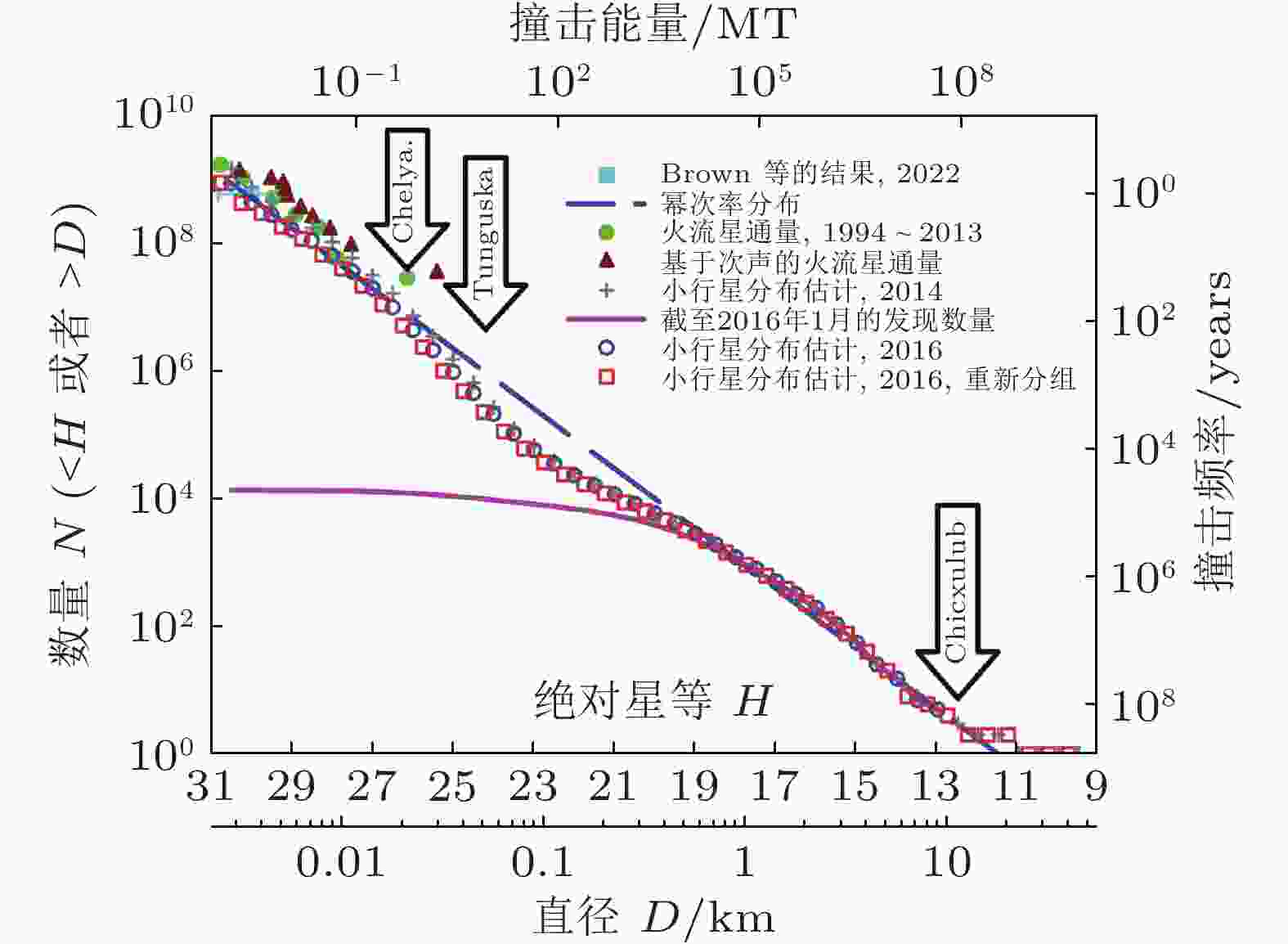
 下载:
下载:
